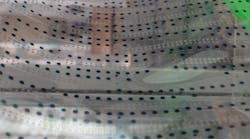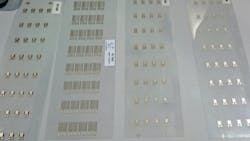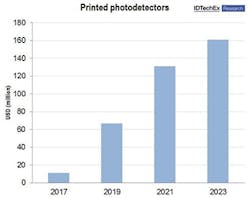Toward the end of August, the Department of Defense and several private organizations invested $171 million to establish a new manufacturing institute for thin, flexible sensors. The Flexible Hybrid Electronics Manufacturing Innovation Institute (FHE MII), as it has been called, is focused on reducing the time it will take for these unique sensors to be used in the military, industrial, and consumer fields.
Guillaume Chansin, a senior technology analyst with research firm IDTechEx, notes that large investments are pushing printed sensors out of the research phase and toward mass production. While the consumer electronics industry has made progress in the development of the printed light-emitting diodes (LEDs) used in smartphone displays, the market for printed sensors is still relatively limited. To date, the only sensors that have been printed on a large scale are those with simple structures. Disposable blood glucose sensors, for instance, which are widely used by diabetics, are covered in reagents to induce an electrochemical reaction with glucose.
According to a recent report from IDTechEx, the market for fully printed sensors will earn revenues over $8 billion by 2025. Chansin notes that the technology will increasingly be used in wearable health monitoring, soft robotics, and sensor monitoring for automobiles and aircraft, in addition to harvesting data for the Internet of Things (IoT). Nevertheless, these sensors will not become more widespread until more advanced production lines can be developed.
Several private companies are in the process of engineering new production lines for printed sensors. In France, for instance, Isorg has begun construction on a new manufacturing process to print optical sensors on flexible plastics. These photodetectors are based on organic semiconductors—instead of silicon integrated circuits (ICs)—that absorb light and generate an electric current. The sensors can be printed directly over 600mm2 plastic sheets, with multiple layers of specialized ink applied in a careful pattern. The production line, which will cost almost $22 million to complete, will become operational in 2017.
In a recent article about the IDTechEx report, Chansin noted that while the printing process for photodetectors and the glucose test strips might be similar, the equipment is very different. “A factory producing billions of these sensors every year would not be suitable for manufacturing Isorg’s photodetectors with decent performances,” he said in the article. New manufacturing equipment is necessary for using other materials, such as heat-sensitive polymers and quantum dots.
In the United States, the FHE MII has the potential to make progress in that direction. The institute brings together 96 companies, 11 laboratories, 43 universities, and 15 state organizations, many of which have experience in the field. Brewer Science, a member of the institute, has released prototypes of printed humidity, gas, and temperature sensors. MC10, another FHE MII member, released a head injury sensor with support from Reebok earlier this year.
In addition to integrated packaging and material scaling, the FHE MII has placed an emphasis on developing hybrid systems. This means that printed sensors will also rely on silicon ICs to process information. To create a hybrid system, the ICs will be thinned down, repackaged, and integrated on the flexible substrate. It could result, for example, in a wireless sensor that uses a near-field communication (NFC) chip.
For Chansin, the potential for printed sensors is very high, especially with the growing importance of sensors in building automation and the larger IoT ecosystem. Isorg’s photodetectors, for example, could be used to design store shelves that can detect whether an item is still in stock. In a recent interview with Bloomberg, Malcom Thompson, the executive director of the FHE MII, gave an example of an aircraft wing covered in flexible sensors that monitor structural integrity.


